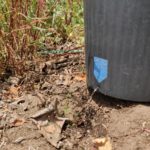Soil building
Feed your soil.
Your soil feeds your plants
and your plants feed you.
— Paraphrased from John Jeavons
When I teach the soil-building session at my class series at the Community Garden at Holy Nativity, I always bring along my little friends – a trio of oversized, gooey brown jelly-plastic earthworms left over from a friend’s Halloween display.
When I pull them out of their box, I make certain to jiggle them, just so, and invariably someone in the audience shrieks. “Are they REAL!?”
I also bring along a copy of Bianca Lavies’ book, Compost Critters. Lavies took her magnifying camera out to her compost pile and photographed everything she found there. Arthropods, slime molds, pill bugs, fungi. Her in-depth photos (eew, I won’t say “gorgeous”) remind us that the earthworms we love and squeal away from are only the visible part of a vast spectrum of life. And to be a successful organic vegetable gardener, we must learn how to take care of that soil life.
It turns out that the soil critters – worms, “bugs,” fungi, bacteria, protozoa, nematodes – work in symbiotic relationships, in productive partnership with your plants. The soil critters help break down particles within the soil so that your plants can access the nutrients. Without lively and active soil life, your plants will starve.
Tiny dogs are really popular pets right now. We all know what it takes to take care of one of those: food, water. Someone who’s thinking carefully might mention shelter or protection. Not too many people remember to list air.
Our earthworms and all their invisible compatriots need the same things: food, water, shelter, air. And as an organic gardener, it’s up to us to make sure they get what they need. Rather than “taking care of our plants,” we need to “take care of our soil critters.”
What do you suppose happens to all these soil critters when we – “just this once” – apply petrochemicals? We sear them out of existence. We wipe the slate clean. We kill off this rich network of soil life. Suddenly we’re dealing with stripped-out, dead, inactive dirt. And we wonder why our garden isn’t doing very well.
We then have to pour more and more chemicals (marketed as “fertilizer”) onto this deadened soil in order to keep our plants going, because there’s nothing alive in the soil to help feed our plant. Each application of sprays, weed killers, etc., perpetuates the dependency. Whatever had gotten established, whatever hatched from the few surviving eggs, has now been obliterated. And we’re faced with starting the rebuilding process all over again.
When we garden organically, the soil critters are our allies. The health of our plants depends upon them. Thus the essence of organic gardening is cultivating this rich series of symbiotic relationships.
Return to Table of Contents


